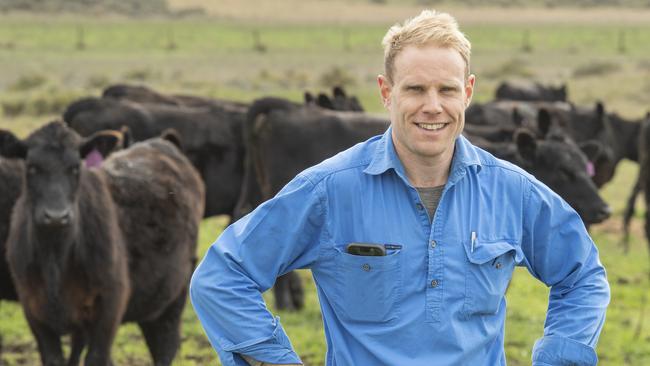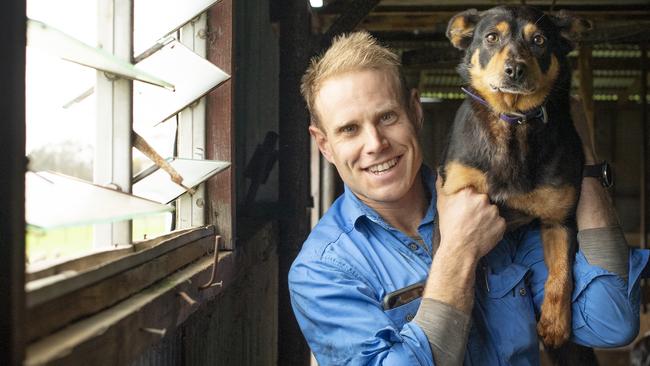Banongill South: Moving into the future
After land was bought back from a major investment company, the ambitious owners behind Banongill South developed grand plans for the future.
Freedom, flexibility and a desire to push the envelope lies at the heart of the Banongill South Pastoral operation in Victoria’s Western District.
For farm manager Oliver Vidor, overseeing the operation at Vite Vite North is an opportunity to spread his wings and take the mixed operation into the future in a dynamic way.
The original Banongill site was settled in the 1850s, and was owned by pastoralist and philanthropist Francis Ormond, who went on to found Ormond College at the University of Melbourne.
The modern-day iteration of Banongill Station was sold by agri-investment company Laguna Bay for about $80 million in late 2020 to a farming consortium, who then split the property.
Under the banner Banongill South, Oliver’s duties include management of a 4700ha section, which includes a fledgling Angus cattle operation, cropping rotations, and a composite ewe and Merino business.
The owners, Ballarat-based Chris and Tanya Mulcahy, have established clear goals to be achieved in the next 10 years.
“It is then up to me as manager and our team to implement the most productive and sustainable enterprises in order to achieve these,” Oliver said.
He works with three full-time employees, a part-time stockman and his wife, Hannah, to put the Mulcahys’ plans into action.
Major goals for Oliver include renovating paddocks to lift potential carrying capacity and renewing vigour in the livestock side of the enterprise to expand the operation’s Angus herd.
TOUGH TASK
The Banongill South property is the biggest piece of the aggregation, and is also some of the most challenging country to work with.
“We’ve probably got the most non-arable country, particularly to the north against the Glenelg Highway. There’s a portion of our cropping country that is low-lying, and does struggle in wet years,” Oliver said.
“Our plan is to take some of that lower land, the poorer performing country, and take it back to livestock.
“This involves removing lots of rocks and then sowing it down with a disc seeder.
“We’ve got plans in place for fencing, and more subdivision. A lot of the country here is that station-like country with large paddocks. Our priority is to make those paddocks smaller for livestock productivity.”

Deployment of fertiliser, lime and phosphorus will be used to increase the carrying capacity of the country, he said.
An additional 200 in-calf Angus heifers, sourced from two different blood lines, were purchased in the past year.
“One line is Paringa Angus blood, the other line is Texas Angus blood,” Oliver said.
“These are currently calving. We are yet to source any bulls for the coming joining season.”
Banongill South includes more than 1000ha of cropping country, with 339ha of canola and 700ha of wheat planted this year. The rotation is two years of wheat followed by a break year of canola or faba beans.
While he has been manager for only about 12 months, big changes have happened under Oliver’s direction.
“We are very flexible … it’s unique here in the way the sale has split up Banongill and for us here at Banongill South, we’ve ended up with an asset base with limited infrastructure,” he said.
Since the sale of the property, Banongill South operates as its own enterprise, with no sharing of capital or equipment.
For Oliver, this system allows him to focus on growth plans, and also the main feature of the enterprise: prime lamb production.
LAMB AMBITION
A total of 11,500 ewes are lambed down, including 8000 mixed-age composites, 2300 composite ewe lambs and 1200 Merinos.
The current ratio of cattle to sheep is 15:85 with the aim to shift that towards 25:75.
About 14,000 sheep are run across the property, with the composite ewe flock the primary share of the sheep enterprise.
A couple thousand Merinos are also included, Oliver said, with the 200 in-calf Angus heifers in the midst of calving.
Composite ewe bloodlines are from Lambpro in Holbrook.
“Essentially, it’s all very new,” Oliver said.
“The previous company at the time had Primeline composite flocks, and we purchased a number of their ewes, then we brought in Merinos for diversity.
“We did the same with the cattle. We’re just trying to work out what that ratio best look likes going forwards, particularly as we take on more of that marginal cropping country.”
A reduction of breeding ewes might occur in the future in favour of cattle, Oliver said.
Changes implemented under Oliver’s stewardship in the past year have resulted in tangible results on-farm, including increasing the number of ewes to lamb down by 3400.
“Year on year we have increased our lambing ewe numbers by 3400.
“This has mainly been achieved by joining ewe lambs for the first time.
“We joined 2700 ewe lambs and 2300 of those scanned in lamb,” Oliver said.
“We have also purchased in a line of Tasmanian-bred Merino ewes.
“We’ve been pushing things hard.”
This year composite ewes scanned 167 per cent, including maiden ewes.
Composite ewe lambs scanned at 125 per cent, and Merino ewes scanned at 150 per cent.
FUTURE FOCUS
A graduate of Marcus Oldham College, Oliver has hit the ground running, and is relishing the opportunity to further his career and farming experience on such a large swath of land.
“Prior, I was at Mount Elephant Station, which is actually our neighbour,” he said.
“I was there for five and a half years as livestock manager. So when this opportunity came up, I was looking to progress my career, and it was a no-brainer.”
The world of agriculture is personally motivating for Oliver, and also a “great lifestyle” for raising his family.
But as he is not a landowner himself, he imagines a time when he will transition away from a farm-based role.
“I would like to see myself as principal of Marcus Oldham College at some point in the future,” he said.

In the meantime, working with owners who are willing to back his decisions and work towards increasing productivity provides a sense of stability and guidance.
“It’s good to have these initial goals established, so you’ve got something to work towards, otherwise it can get a bit overwhelming with the scale and the nature of the property,” he said.
“It’s not like a 50-year-old property where the same enterprise has been run … we are very flexible and can take the business in the way we want to, in the most profitable way, working best on the country.”





